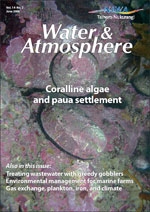PDF of this article (81 KB)

'Water in the woolshed' road-show

Agriculture covers about half of New Zealand’s land surface and generates half our traded exports; recent intensification has meant more fertiliser, stock, and farm infrastructure such as drainage, tracks, and fencing. While intensification has improved the economic returns of farming, it can come at an environmental cost, and there is evidence of deterioration in downstream water values due to increased runoff of pathogens, nutrients, and sediment from agricultural land, and stock damage to riparian areas. Addressing these issues is key to maintaining our 'clean, green' values and image as a trading country and tourist destination.
NIWA scientists have teamed up with AgFirst and regional councils to provide workshops for dry-stock farmers on 'Intensifying your farm: what are the effects?' Funded by the Sustainable Management Fund (Ministry for the Environment) and contributions from participating regional councils, we staged 13 half-day workshops around the country, from Northland to Southland, Taranaki to Gisborne.
In the workshops we discussed pathways of contaminants from land to water and the effects on habitats, along with a range of practical ways that these can be controlled. Farmers were encouraged to think of win:win solutions, where environmental benefits may also bring about improved productivity and farm value. Tools include matching land use to its capability (stock type and grazing management to soil type, fertiliser use, soil conservation), ways of controlling stock damage to streams, and wetland and riparian management. Most of the workshops were held on a farm – usually in the woolshed – and included a farm tour to see measures the host farmers have put in place to manage farming effects on water.
This is a small step on the road to improving the sustainability of our farming. Feedback from the farmers indicates this format of taking science to the farm works well, and it’s a step in the right direction.
For further information, contact: Dr John Quinn, 0-7-856 1735, [email protected] Dr Steph Parkyn, 0-7-856 1786, [email protected] Sally Hobson (AgFirst), 0-7-834 6824, [email protected]
Update on UV
For three days in April, about 65 scientists and policy advisors attended NIWA’s UV workshop in Dunedin – 'UV radiation and its effects: an update'. Although the focus was on the New Zealand region, contributions from other countries included Australia, Austria, Germany, and USA.
UV radiation lies at the crossroads of several diverse scientific disciplines, so the range of topics discussed was broad. Papers at the workshop included the causes and effects of ozone depletion and their interactions with climate change; the effects of UV on the biosphere, including aquatic and terrestrial ecosystems, materials, and human health; and communicating behavioural messages to the public.
Workshop participants heard that, although ozone depletion will be less of an issue in the future, the intensities of summertime UV in New Zealand will remain high compared with other mid-latitude locations. These high UV intensities contribute to deleterious effects as diverse as reduced biological productivity, damage to building materials, and increased risk of skin cancer. The meeting also heard that our wintertime UV intensities are relatively low, so we have extremely large annual variabilities in UV, especially in the south of the country. This is thought to be an important factor in the low levels of vitamin D found in the New Zealand population.
Several papers and posters discussed the ways vitamin D mediates a wide range of health concerns, including osteoporosis, diabetes, and many forms of cancer. It is important that the public has access to timely information about UV intensities in their regions throughout the year, and not just during the summer months. Further, it is vital that appropriate SunSmart behavioural messages are provided to the public, to reflect both the negative aspects of UV in the summer and possible beneficial effects of UV in the winter, especially in the country’s south.
In the light of these factors, the meeting resolved to endorse the position statement on the risks and benefits of sun exposure in New Zealand adopted by key stakeholders in 2005 (see www.sunsmart.org.nz/sunvitamind.asp). Participants also took the opportunity to plan for future collaborations, such as to better understand relationships between UV radiation, vitamin D, and the health of New Zealanders.
The workshop was sponsored by the Royal Society of New Zealand, the Cancer Society, the Health Sponsorship Council, the Ministry of Health, and NIWA, and was well-covered by the media. As for the previous three UV workshops, extended abstracts of the proceedings will be published as a Royal Society Miscellaneous Publication; the papers are also available on the NIWA website.
For further information, contact: Dr Richard McKenzie, 0-3-447 3348, [email protected], www.niwascience.co.nz/rc/atmos/uvconference/ Wendy Billingsley, (021)176 7563, [email protected], www.sunsmart.co.nz
